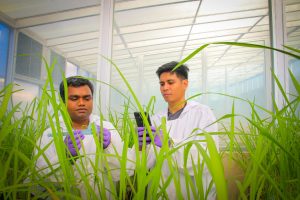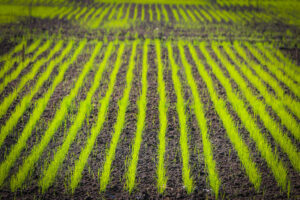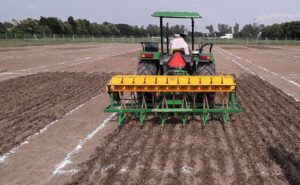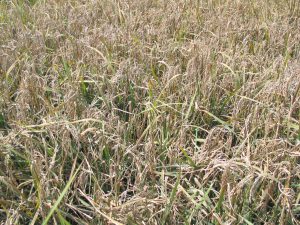Even before the dramatic price spike in early 2008, rice prices on the world market increased every year from 2001 to 2007. Never before in the post-World War II period had they increased for more than 3 consecutive years. Even after adjusting for inflation, average prices in 2007 were 64% greater than in 2001. There were many factors that contributed to this rise in prices, including the depreciation of the US dollar, falling real interest rates, and rising oil prices that led to higher fertilizer prices.
One very important factor that has been much overlooked, however, is the slowdown in rice yield growth in Asia, where about 90% of the world’s rice is produced and consumed. Although rice yields are still growing, the rate of growth has been declining steadily for many years. Fortunately, population growth in rice-producing Asia has been steadily declining for even longer. Since population growth is the main source of rice demand growth, this trend helped to keep rice prices in check for a time.
But since the mid-1990s, population growth has exceeded rice yield growth and the gap has been growing steadily larger, creating a significant imbalance between supply and demand. This trend is evident for Asia as a whole, but also separately for East Asia, Southeast Asia, and South Asia. Part of this gap was filled for a time by increasing the area harvested, but rice area peaked in Asia in 1999.
 To be sure, some of the slowdown in yield growth may be due to lower world prices leading to reduced supply. However, world prices were relatively constant from 1986 to 1998, when rice yield growth declined substantially. Thus, the major decline in yield growth preceded the decline in world prices from 1999 to 2001, suggesting that prices are far from the whole story.
To be sure, some of the slowdown in yield growth may be due to lower world prices leading to reduced supply. However, world prices were relatively constant from 1986 to 1998, when rice yield growth declined substantially. Thus, the major decline in yield growth preceded the decline in world prices from 1999 to 2001, suggesting that prices are far from the whole story.
Further, world corn prices have followed a broadly similar pattern to world rice prices during the past two decades, but, unlike rice, corn yield growth was much higher during the past 10 years than during the 1980s. And, it is domestic prices, not world prices, that affect farmers’ decisions, and domestic prices in many countries have been quite stable when viewed from a longer term perspective (excluding events in 2008).
The widening imbalance between population growth and yield growth points to the need for more agricultural research. The funding of the International Rice Research Institute, for example, after adjusting for inflation, has declined nearly 50% since its peak in 1993.
Furthermore, the share of agricultural research funding to the Consultative Group on International Agricultural Research (an association of donor agencies that funds IRRI and 14 other centers) devoted to the core task of increasing productivity has declined over the past 15 years, as research goals have diversified toward other objectives. These declines are unfortunate, especially in light of research by Shenggen Fan and colleagues at the International Food Policy Research Institute that shows that, among various public goods, agricultural research has made one of the largest contributions to poverty reduction in developing countries.
Fortunately, agricultural research funding has not declined everywhere. In fact, agricultural research intensity (the ratio of agricultural research expenditures to agricultural gross domestic product) increased in most Asian countries between 1991 and 2002. While the increase is welcome, research intensity is still below 0.5% in nearly all Asian countries—less than half the optimal ratio suggested by experts.1 This suggests that more spending on agricultural research at both national and international levels can reduce poverty and increase economic growth.
_________________________________________
David Dawe is a senior economist at the United Nations Food and Agriculture Organization.










